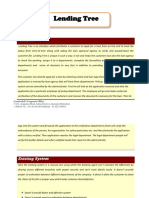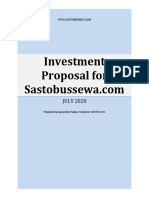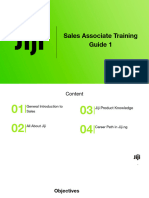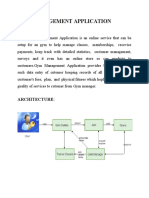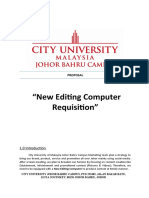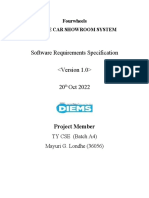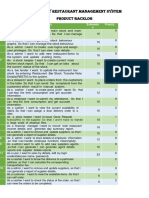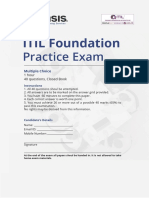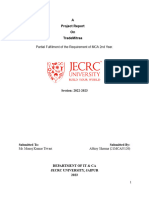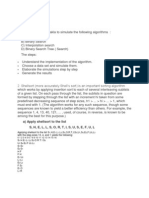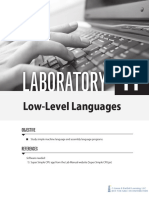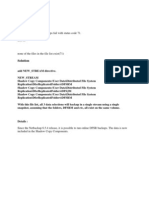Classified Management System Project Report
Uploaded by
ranjitmahajanClassified Management System Project Report
Uploaded by
ranjitmahajanMini Project Report 2009
A Multi-Tier Online Booking Of Classifieds
INTRODUCTION
Multi-Tier Ad Booking System
One of the problems facing magazines is organizing their advertisement
books. The high-end is well covered with specialist software serving publications which
can afford many thousands. What is there for less? Investigation continues, but in the
meantime there are systems below which range from the low thousands up.
This is an ad booking system producing a wide variety of reports. Entry is
browser based. It runs on a Windows XP server using SQL server as its database.
The Enterprise system provides ad salespeople with the most effective tools
to book, schedule, price, and process ads, including classified liner ads, display ads,
combined classified and display ads, Web ads, and inserts. The system integrates and
streamlines all facets of advertising sales, production and management processes: order
entry, scheduling, pricing, composition, pagination, and reporting.
Department of Information Technology
CUIET
Mini Project Report 2009
A Multi-Tier Online Booking Of Classifieds
1.1 Multi-Tier Application Architecture
Web-based applications are multitier applications (sometimes referred to as
n-tier applications). Multitier applications divide functionality into separate tiers (i.e.,
logical groupings of functionality). Although tiers can be located on the same computer,
the tiers of Web-based applications typically reside on separate computers. Figure
presents the basic structure of a three-tier Web-based application.
The information tier (also called the data tier or the bottom tier) maintains
data pertaining to the application. This tier typically stores data in a relational database
management system (RDBMS).
The middle tier implements business logic, controller logic and presentation
logic to control interactions between the application's clients and the application's data..
The middle-tier controller logic processes client requests and retrieves data from the
database. The middle-tier presentation logic then processes data from the information tier
and presents the content to the client.
The client tier, or top tier, is the application's user interface, which gathers
input and displays output. Users interact directly with the application through the user
interface. In response to user actions the client tier interacts with the middle tier to make
requests and to retrieve data from the information tier. The client tier then displays data
retrieved from the middle tier to the user.
Department of Information Technology
CUIET
Mini Project Report 2009
A Multi-Tier Online Booking Of Classifieds
1.2 Application Architecture Diagram
The application has multi-tier architecture :
Department of Information Technology
CUIET
Mini Project Report 2009
A Multi-Tier Online Booking Of Classifieds
Iterative Development Model
An alternative approach is the Iterative Development Life Cycle (sometimes
referred to as the Spiral Life Cycle).
Department of Information Technology
CUIET
Mini Project Report 2009
A Multi-Tier Online Booking Of Classifieds
With the Iterative Life Cycle, analysis is done just the same as with the
Waterfall method. However, once analysis is done, each requirement is prioritized as
follows:
High - These are mission critical requirements that absolutely have to be done in the
first release.
Medium - These are requirements that are important but can be worked around until
implemented.
Low - These are requirements that are nice-to-have but not critical to the operation of
the software.
Once priorities have been established, the releases are planned. The first
release (Release 1.0) will contain just the High priority items and should take about 1 to 3
months to deliver.
Below are the advantages of the Iterative Life Cycle:
The Design phase goes much faster, as designs are only done on the items in the
current release (Release 1.0 for example).
Coding and Testing go much faster because there are less items to code and test.
If major design flaws are found, re-work is much faster since the functional areas
have been greatly reduced.
The client gets into production in less than 3 months, allowing them to begin
earning revenue or reducing expenses quicker with their product.
If market conditions change for the client, changes can be incorporated in the
next iterative release, allowing the software to be much more nimble.
As the software is implemented, the client can make recommendations for the
next iteration due to experiences learned in the past iteration.
Department of Information Technology
CUIET
Mini Project Report 2009
A Multi-Tier Online Booking Of Classifieds
SYSTEM ANALYSIS
2.1 System study
A system is a combination of resources working together to convert input to
output that moves through a series of stages or phases to deliver the system in-line with
the user requirements.
Analysis is a detailed study of the various operations performed by a system
and their relationships within and outside the system.
The study phase is the first phase involved in the creation of a computerbased system. It is the phase in which problems are identified, alternate solutions are
evaluated and the most feasible system recommended during a preliminary analysis is
permitted. A technical and economical evaluation of the proposed system is conducted.
2.2 Existing system
Now there exist some discreet systems that help the companies with minimal
information. The programmers need extra effort to do their duties because of the lack of
framework.
Existing System and its Drawbacks
The existing system works manually. All the reports are kept as files and also
each data of the undertaken project is maintained by using files. It involves much
manpower and time to perform simple enquiry like requirements also.
Department of Information Technology
CUIET
Mini Project Report 2009
A Multi-Tier Online Booking Of Classifieds
2.3 Proposed system
The proposed system is a computerized system, since computers are
electronic devices it never gets bored up of the repeated tasks assigned to it.
The cutting advantage of the computers is its capacity to store large amount
data, its speed and accuracy in its work.
Using these abilities in right perspective, one can improve the working
condition of a system. Speed is the most necessary thing in any business. The progress of
any system depends on its customer satisfaction. In manual system the accuracy of all
calculations may be less.
In manual system the data are stored in the forms of registers and records
therefore it can store less data compared to computer. Also there is chance of missing
records after some time. This may cause problem in the functioning of the manual system
in future whereas in computer a large amount of data can be stored in comparatively
smaller area.
This system provides speed and accurate handling of information. Thus it
gives us the provisions for enquiry, admission, staffing, reporting etc. are more efficiently
and user-friendly.
Department of Information Technology
CUIET
Mini Project Report 2009
A Multi-Tier Online Booking Of Classifieds
2.4 Feasibility study
All projects are feasible when given unlimited resources and infinite time. It
is both necessary and prudent to evaluate the feasibility of a project at the earliest
possible time. A feasibility study is not warranted for systems in which economic
justification is obvious, technical risk is low, few legal problems are expected and no
reasonable alternative exists. An estimate is made of whether the identified user needs
may be satisfied using current software and hardware technologies. The study will
decide if the proposed system will be cost effective from the business point of view and
if it can be developed in the given existing budgetary constraints. The feasibility study
should be relatively cheap and quick. The result should inform the decision of whether
to go ahead with a more detailed analysis.
Feasibility study may be documented as a separated report to higher officials
of the top-level management and can be included as an appendix to the system
specification. Feasibility and risk analysis is related in many ways. If there is more
project risk then the feasibility of producing the quality software is reduced.
The study is done in these phases
Operational feasibility
Technical feasibility
Economical feasibility
Behavioral feasibility
Software feasibility
Hardware feasibility
Department of Information Technology
CUIET
Mini Project Report 2009
A Multi-Tier Online Booking Of Classifieds
2.4.1 Operational Feasibility
Proposed projects are beneficial only if they can be turned into information
systems that will meet the organization's operating requirements. Simply stated, this test
of feasibility asks if the system will work when it is developed and installed. Are there
major barriers to implementation? Here are questions that will help test the operational
feasibility of a project:
Is there sufficient support for the project from management?
Are current business methods acceptable to the users?
Have the users been involved in the planning and development of the
project?
Will the proposed system cause harm?
The purpose of the operational feasibility study is to determine whether the
new system will be used if it is developed and implemented. And whether there will be
resistance from users that will undermine the possible application benefits.
There was no difficulty in, implementing the system and the proposed system
is so effective, user friendly and functionally reliable so that the users in the company
will find that the new system reduce their hard-steps. If the users of the system are fully
aware of the internal working of the system then the users will not be facing any problem
in running the system.
Department of Information Technology
CUIET
Mini Project Report 2009
A Multi-Tier Online Booking Of Classifieds
2.4.2 Technical feasibility
A study of function, performance and constraints may improve the ability to
create an acceptable system. Technical feasibility is frequently the most difficult area to
achieve at the stage of product engineering process.
Considering that are normally associated with the technical feasibility
include
Development risk
Resource availability
Technology
Technical feasibility study deals with the hardware as well as software
requirements. The scope was whether the work for the project is done with the current
equipments and the existing software technology has to be examined in the feasibility
study. The outcome was found to be positive.
In the proposed system, data can be easily stored and managed using
database management system software. The reports and results for various queries can be
generated easily. Therefore , the system is technically feasible.
Department of Information Technology
10
CUIET
Mini Project Report 2009
A Multi-Tier Online Booking Of Classifieds
2.4.3 Economical feasibility
A cost evaluation is weighed against the ultimate income or benefit derived
from the developed system or product. Economic j1.lstification is generally the "bottomline" consideration that includes cost benefit analysis, long term corporate income
strategies, impact on other profit centers or products, cost of resources needed for
development and potential market growth. When compared to the advantage obtained
from implementing the system its cost is affordable. Also the system is designed to meet
the modifications required in the future. So most of the required modifications can be
done without much re-work.
Proposed system was developed with the available resources. Since cost
input for the software is almost nil the output of the software is always a profit. Hence
Software is economically feasible.
In the existing system, manpower is more required. In the proposed system,
number of employees to be involved is reduced drastically. So, the proposed system is
said to be economic.
In the existing system, storage of the records should be properly done and
security should be provided for the records. In the proposed system, the software
provides security and maintenance and it hardly needs one or two persons to operate the
system.
Department of Information Technology
11
CUIET
Mini Project Report 2009
A Multi-Tier Online Booking Of Classifieds
2.4.4 Behavioral Feasibility
People are inherently resistant to changes and computer is known for
facilitating the changes. An estimate should be made of how strongly the user staff reacts
towards the developments of the computerized system.
In the existing system more manpower is required and time factor is more. In
the proposed system, both man power and time factors are reduced and also unnecessary
burden is reduced. Thus, the remaining people are made to engage in some other
important work. Therefore, the system is behaviorally feasible.
2.4.5 Software feasibility
Even though software is developed in a very high software environment, it
will be supported by many other platforms and environments with minimum changes.
2.4.6 Hardware feasibility
The software can be developed with resource already existing. Here the
consideration is that the existing hardware resources support the technologies that are to
be used by the new system. No hardware was newly bought for the project and hence.
Software is said to achieve hardware feasibility.
Department of Information Technology
12
CUIET
Mini Project Report 2009
A Multi-Tier Online Booking Of Classifieds
SYSTEM SPECIFICATION
3.1 Hardware requirements
Minimum Requirements
Processors : Intel Pentium Pro or Processor running at 133 MHz
Hard Disk : 1.2 GB Hard Disk
RAM
: Client Level Minimum 128MB
Recommended Requirements for peak performance
Processors
: Intel Pentium III running at 450 MHz
RAM
: Client Level Minimum 512MB
Display Type
: SVGA Color Monitor
Keyboard
: Enhanced 104 Standard
Mouse
: PS/2 2 Button
3.2 Software requirements
Operating System : WINDOWS XP & Higher Versions
Tools Used
Front End
Back End
: C#.Net
: SQL Server 2005
Technology Used
ASP.NET
Department of Information Technology
13
CUIET
Mini Project Report 2009
A Multi-Tier Online Booking Of Classifieds
3.3 Software features
Visual C#.Net:
C# is simple, powerful, type-safe, and object-oriented. With its many
innovations, C# enables rapid application development while retaining the expressiveness
and elegance of C-style languages Visual Studio supports Visual C# with a full-featured
Code Editor, project templates, designers, code wizards, a powerful and easy-to-use
debugger, and other tools.
The .NET Framework class library provides access to a wide range of
operating system services and other useful, well-designed classes that speed up the
development cycle significantly.
The C# language is clearly the star of the whole .Net mega-production, with
Visual Basic.Net as its sidekick. C# and its 'Java-like' qualities -- such as garbage
collection and hierarchical namespaces -- have received lots of attention. VB.Net syntax
remains verbose, while C# more closely resembles C -- but both languages access the
same programming framework and compile to nearly identical MSIL code.
Department of Information Technology
14
CUIET
Mini Project Report 2009
A Multi-Tier Online Booking Of Classifieds
Database Management System
Database is an integrated set of interrelate data stored in online medium with
controlled redundancy to several applications within an enterprise. A Database
Management System is a software system that manages the base of an enterprise and
provides facilities to the users to use the database within practical case.
In relational database approach, data is organized in logical mathematical
sets, in a tabular structure.
The data field becomes a column in a table under relational model, and each
record becomes a row in a table. Relationship between various table area defined through
the use of mathematical function, such as JOIN and UNION. The most important
advantage of the relational model is its flexibility in describing the relationships between
the various data items. Primary purpose behind relational model is the preservation of
data integrity, which implies that data must be stored in a format that prevents it from
being accessed from outside the DBMS that created it.
The emphasis on the data integrity makes the relational model ideal for
traction processing systems, and thus for multi-user and client/server database.
Department of Information Technology
15
CUIET
Mini Project Report 2009
A Multi-Tier Online Booking Of Classifieds
A DBMS is computer software that manages access to database. A typical
multi-user DBMS performs the following tasks and more:
A DBMS safety manages shared access to a single database among multiple
concurrent users.
A DBMS leverages computer resources wisely so that a large number of
application users can perform work with fast response times for maximum productivity.
A DBMS protects database information in such a way that it can reconstruct
work lost due to every thing from a single power outage of catastrophic site disasters.
SQL Server 2005
Microsoft SQL Server 2005 is a set of components that work together to
meet the data storage and analysis needs of the largest Web sites and enterprise data
processing systems. Microsoft SQL Server 2005 data is stored in databases. The data
in a database is organized into the logical components visible to users. A database is also
physically implemented as two or more files on disk.
When using a database, you work primarily with the logical components
such as tables, views, procedures, and users. The physical implementation of files is
largely transparent. Typically, only the database administrator needs to work with the
physical implementation.
Department of Information Technology
16
CUIET
Mini Project Report 2009
A Multi-Tier Online Booking Of Classifieds
Features of SQL Server 2005
Microsoft SQL Server 2005 features include:
Internet Integration.
The SQL Server 2005 database engine includes integrated XML support. It
also has the scalability, availability, and security features required to operate as the data
storage component of the largest Web sites.
Scalability and Availability.
The same database engine can be used across platforms ranging from laptop
computers running Microsoft Windows 98 through large, multiprocessor servers running
Microsoft Windows 2000 Data Center Edition. SQL Server 2005 Enterprise Edition
supports features such as federated servers, indexed views, and large memory support
that allow it to scale to the performance levels required by the largest Web sites.
Enterprise-Level Database Features
The SQL Server 2005 relational database engine supports the features
required to support demanding data processing environments. The database engine
protects data integrity while minimizing the overhead of managing thousands of users
concurrently modifying the database.
Ease of installation, deployment, and use
SQL Server 2005 includes a set of administrative and development tools that
improve upon the process of installing, deploying, managing, and using SQL Server
across several sites.
Department of Information Technology
17
CUIET
Mini Project Report 2009
A Multi-Tier Online Booking Of Classifieds
SQL Server 2005 also supports a standards-based programming model
integrated with the Windows DNA, making the use of SQL Server databases and data
warehouses a seamless part of building powerful and scalable systems.
Data warehousing
SQL Server 2005 includes tools for extracting and analyzing summary data
for online analytical processing. SQL Server also includes tools for visually designing
databases and analyzing data using English-based questions.
Department of Information Technology
18
CUIET
Mini Project Report 2009
A Multi-Tier Online Booking Of Classifieds
Database Architecture
Microsoft SQL Server 2005 data is stored in databases. The data in a
database is organized into the logical components visible to users. A database is also
physically implemented as two or more files on disk. Each instance of Sql Server has
four system databases (master, model, tempdb, and msdb) and one or more user
databases.
Some organizations have only one user database, containing all the data for
their organization. Some organizations have different databases for each group in their
organization, and sometimes a database used by a single application. For example, an
organization could have one database for sales, one for payroll, one for a document
management application, and so on. Sometimes an application uses only one database;
other applications may access several databases.
It is not necessary to run multiple copies of the SQL Server database engine
to allow multiple users to access the databases on a server. An instance of the SQL Server
Standard or Enterprise Edition is capable of handling thousands of users working in
multiple databases at the same time. Each instance of SQL Server makes all databases in
the instance available to all users that connect to the instance, subject to the defined
security permissions.
Department of Information Technology
19
CUIET
Mini Project Report 2009
A Multi-Tier Online Booking Of Classifieds
ASP.NET Features
ASP.NET is not just a simple upgrade or the latest version of ASP. ASP.NET
combines unprecedented developer productivity with performance, reliability, and
deployment. ASP.NET redesigns the whole process. It's still easy to grasp for new comers
but it provides many new ways of managing projects. Below are the features of ASP.NET.
Easy programming model
ASP.NET makes building real world Web applications dramatically
easier. ASP.NET server controls enable an HTML like style of declarative programming
that let you build great pages with far less code than with classic ASP. Displaying data,
validating user input, and uploading files are all amazingly easy. Best of all, ASP.NET
pages work in all browsers including Netscape, Opera, Firefox and Internet Explorer.
Flexible language options
ASP.NET lets you leverage your current programming language skills.
Unlike classic ASP, which supports only interpreted VBScript and JScript, ASP.NET now
supports more than 25 .NET languages (built-in support for VB.NET, C#, and
JScript.NET), giving you unprecedented flexibility in your choice of language.
Great tool support
You can harness the full power of ASP.NET using any text editor, even
notepad.
But Visual Studio .NET adds the productivity of Visual Basic-style
development to the Web. Now you can visually design ASP.NET Web Forms using
familiar drag-drop-doubleclick techniques, and enjoy full-fledged code support including
statement completion and color-coding. VS.NET also provides integrated support for
debugging and deploying ASP.NET Web applications.
Department of Information Technology
20
CUIET
Mini Project Report 2009
A Multi-Tier Online Booking Of Classifieds
The Enterprise versions of Visual Studio .NET deliver life-cycle features to help
organizations plan, analyze, design, build, test, and coordinate teams that develop
ASP.NET Web applications. These include UML class modeling, database modeling
(conceptual, logical, and physical models), testing tools (functional, performance and
scalability), and enterprise frameworks and templates, all available within the integrated
Visual Studio .NET environment.
Rich Class Framework
Application features that used to be hard to implement, or required a 3rdparty component, can now be added in just a few lines of code using the .NET
Framework. The .NET Framework offers over 4500 classes that encapsulate rich
functionality like XML, data access, file upload, regular expressions, image generation,
performance monitoring and logging, transactions, message queuing, SMTP mail, and
much more. With Improved Performance and Scalability ASP.NET lets you use serve
more users with the same hardware.
Compiled execution
ASP.NET is much faster than classic ASP, while preserving the "just hit save"
update model of ASP. However, no explicit compile step is required. ASP.NET will
automatically detect any changes, dynamically compile the files if needed, and store the
compiled results to reuse for subsequent requests. Dynamic compilation ensures that your
application is always up to date, and compiled execution makes it fast.
Rich output caching
ASP.NET output caching can dramatically improve the performance and
scalability of your application. When output caching is enabled on a page, ASP.NET
executes the page just once, and saves the result in memory in addition to sending it to
the user. When another user requests the same page, ASP.NET serves the cached result
Department of Information Technology
21
CUIET
Mini Project Report 2009
A Multi-Tier Online Booking Of Classifieds
from memory without re-executing the page. Output caching is configurable, and can be
used to cache individual regions or an entire page.
Web-Farm Session State
ASP.NET session state lets you share session data user-specific state values
across all machines in your Web farm. Now a user can hit different servers in the Web
farm over multiple requests and still have full access to her session. And since business
components created with the .NET Framework are free-threaded, you no longer need to
worry about thread affinity.
Enhanced Reliability
ASP.NET ensures that your application is always available to your users.
Memory Leak, DeadLock and Crash Protection
ASP.NET automatically detects and recovers from errors like deadlocks and
memory leaks to ensure your application is always available to your users. For example,
say that your application has a small memory leak, and that after a week the leak has tied
up a significant percentage of your server's virtual memory. ASP.NET will detect this
condition, automatically start up another copy of the ASP.NET worker process, and direct
all new requests to the new process. Once the old process has finished processing its
pending
requests,
it
is
gracefully
disposed
and
the
leaked
memory
is
released. Automatically, without administrator intervention or any interruption of service,
ASP.NET has recovered from the error.
Easy Deployment
ASP.NET takes the pain out of deploying server applications. "No touch"
application
deployment. ASP.NET
dramatically
simplifies
installation
of
your
application. With ASP.NET, you can deploy an entire application as easily as an HTML
page, just copy it to the server. No need to run regsvr32 to register any components, and
configuration settings are stored in an XML file within the application.
Department of Information Technology
22
CUIET
Mini Project Report 2009
A Multi-Tier Online Booking Of Classifieds
Dynamic update of running application
ASP.NET now lets you update compiled components without restarting the
web server. In the past with classic COM components, the developer would have to
restart the web server each time he deployed an update. With ASP.NET, you simply copy
the component over the existing DLL, ASP.NET will automatically detect the change and
start using the new code.
Easy Migration Path
You don't have to migrate your existing applications to start using ASP.NET.
ASP.NET runs on IIS side-by-side with classic ASP on Windows 2000 and Windows XP
platforms. Your existing ASP applications continue to be processed by ASP.DLL, while
new ASP.NET pages are processed by the new ASP.NET engine. You can migrate
application by application, or single pages. And ASP.NET even lets you continue to use
your existing classic COM business components.
XML Web Services
XML Web services allow applications to communicate and share data over
the Internet, regardless of operating system or programming language. ASP.NET makes
exposing and calling XML Web Services simple. Any class can be converted into an
XML Web Service with just a few lines of code, and can be called by any SOAP client.
Likewise, ASP.NET makes it incredibly easy to call XML Web Services from your
application. No knowledge of networking, XML, or SOAP is required.
Mobile Web Device Support
ASP.NET Mobile Controls let you easily target cell phones, PDAs and over
80 mobile Web devices. You write your application just once, and the mobile controls
automatically generate WAP/WML, HTML, or iMode as required by the requesting
device.
Department of Information Technology
23
CUIET
Mini Project Report 2009
A Multi-Tier Online Booking Of Classifieds
SYSTEM DESIGN
System design is the process of developing specifications for a candidate
system that meet the criteria established in the system analysis. Major step in system
design is the preparation of the input forms and the output reports in a form applicable to
the user.
The main objective of the system design is to use the package easily by any
computer operator. System Design is the creative act of invention, developing new inputs,
a database, offline files, method, procedures and output for processing business to meet
an organization objective. System design builds information gathered during the system
analysis.
4.1 Introduction
System design is a solution for, how to approach the creation of a new
system? It provides the understanding and procedural details necessary for implementing
the proposed system.The purpose of this software phase is to design the software system
in sufficient detail so that the sub-system can be correctly coded and tested. Software
design is the process of designing a system by identifying its major components,and
iterating until the desired level of detail is achieved. Software design is initiated when
software requirements have been properly identified and documented. This phase ends
when the software design documentation is judged to be complete and correct..
Department of Information Technology
24
CUIET
Mini Project Report 2009
A Multi-Tier Online Booking Of Classifieds
4.2 Modularization details
All the programs are menu-driven. Each menu provides the user with options
which can perform different tasks. The main modules in this software are Administrator
module and Agent module.
Customer Entry
It is provided for entering customer details like name, address, email-id etc.
Agent Register Form
It is provided for entering agent details like name, address, email-id etc.
Rate Settings
It is provided for specifying details like page number, column size in news
papers, magazines etc. It also specifies the amount and description about the Ads.
Status update
It is used for displaying booking Id, customer name, column size, page
number, publishing date, booking date.
Login
This screen consist of login options for customer ie to enter their user name
& password.
Agent booking
It is used for displaying booking Id, customer name, column size, page
number, publishing date, booking date, select file.
Department of Information Technology
25
CUIET
Mini Project Report 2009
A Multi-Tier Online Booking Of Classifieds
4.3 Database design
The overall objective in the development of database technology has been to
treat data as an organizational resource and as an integrated whole. Database
Management System allows data to be protected and organized separately from other
resources. Database is an integrated collection of data. This is the difference between
logical and physical data.
The organization of data in the database aims to achieve three major
objectives:
1.
Data integration
2.
Data integrity
3.
Data independence
The databases are implemented using a DBMS package. Each particular
DBMS has unique characteristics and general techniques for database design.
Normalization
The process of normalization is concerned with the transformation of
the conceptual schema to a computer representable form. Normalization reduces the
redundancies and anomalies.
The First Normal Form
First normal form does not allow multivalued and composite valued
attributes. It states that the domain of an attribute must include only atomic values and
that value of any attribute in a tuple must be single value from the domain of that
attribute.
Department of Information Technology
26
CUIET
Mini Project Report 2009
A Multi-Tier Online Booking Of Classifieds
The Second Normal Form
In second normal form, for relations where primary key contains
multiple attributes, non key attributes should not be functionally dependent on a part of
the primary key.
Third Normal Form
In third normal form, relation should not have a non-key attribute
functionally determined by another non-key attribute. That is there should be no
transitive dependency of a non-key attribute on the primary key.
Department of Information Technology
27
CUIET
Mini Project Report 2009
A Multi-Tier Online Booking Of Classifieds
Admin Module
0th Level
Admin
Department of Information Technology
Online
Booking of
Classifieds
28
Database
CUIET
Mini Project Report 2009
A Multi-Tier Online Booking Of Classifieds
1st Level
Admin
Login
User
Rate
Setting
s
Agent
Registration
View
Online
Booking
Agent details
Rate table
Booking Details
Department of Information Technology
29
CUIET
Mini Project Report 2009
A Multi-Tier Online Booking Of Classifieds
2nd Level
Admin
Login
User
Rate
Settings
Agent
Registration
View
Online
Booking
Agent details
Rate table
Booking Details
Download
contents
Files
Send
Confirmation
to Agent
Department of Information Technology
30
Confirmation
CUIET
Mini Project Report 2009
A Multi-Tier Online Booking Of Classifieds
Agent Module
0th Level
Agent
Department of Information Technology
Online
Booking
of
Classified
s
31
Database
CUIET
Mini Project Report 2009
A Multi-Tier Online Booking Of Classifieds
1stLevel
Agent
User
Login
View
confirmati
ons
Customer
registratio
n
Customer
Online
booking
confirmation
Booking details
Department of Information Technology
32
CUIET
Mini Project Report 2009
A Multi-Tier Online Booking Of Classifieds
2nd Level
Agent
User
Login
View
confirmation
s
Customer
registration
Customer
Online
booking
confirmation
Booking details
Upload
contents
Department of Information Technology
33
Files
CUIET
Mini Project Report 2009
A Multi-Tier Online Booking Of Classifieds
TABLE DESIGN
Tbl_agentdetails
Column Name
fld_agid
fld_agname
fld_agaddress
fld_agcontactno
fld_agemail
fld_userslno
fld_agstatus
Data Type
int
varchar
varchar
varchar
varchar
int
bit
Size
50
50
50
50
0 or 1
Tbl_booking
Column Name
fld_bookid
fld_agid
fld_setid
fld_pubdate
fld_bookdate
fld_custid
Data Type
int
int
int
datetime
datetime
int
fld_filepath
varchar
Department of Information Technology
Size
50
34
CUIET
Mini Project Report 2009
A Multi-Tier Online Booking Of Classifieds
Tbl_bookingstatus
Column Name
fld_bookid
Data Type
int
fld_status
fld_description
bit
varchar
Size
0 or 1
50
Tbl_customer
Column Name
fld_custid
fld_custname
fld_custaddr
fld_custcontactno
Data Type
int
varchar
varchar
varchar
fld_custemail
fld_agid
varcahar
int
Fld_custstatus
bit
Department of Information Technology
Size
50
50
50
50
0 or 1
35
CUIET
Mini Project Report 2009
A Multi-Tier Online Booking Of Classifieds
Tbl_settings
Column Name
fld_setid
fld_pgno
fld_colsize
fld_amount
fld_description
Data Type
int
int
varchar
numeric
varchar
Size
50
18,0
50
Tbl_user
Column Name
fld_userslno
fld_username
fld_userpass
fld_usertype
Department of Information Technology
Data Type
int
varchar
varchar
varchar
36
Size
50
50
50
CUIET
Mini Project Report 2009
A Multi-Tier Online Booking Of Classifieds
SCREEN DESIGN
Input design
Input design is the process of converting the user-originated inputs to a
computer-based format. The design for handling input specifies how data are accepted for
computer processing. Input design is a part of overall system design that needs careful
attention and if includes specifying the means by which actions are taken. A system user
interacting through a workstation must be able to tell the system whether to accept input
produce a report or end processing. The collection of input data is considered to be the
most expensive part of the system design. Since the inputs have to be planned in such a
manner so as to get the relevant information extreme care is taken to obtain the
information. If the data going into the system is incorrect then the processing and outputs
will magnify these errors. The major activities carried out are
Collection of needed data from the source
Conversion of data into computer accepted from
Verification of converted data
Checking data for accuracy
The following are the major input screens used for CARGO
MANAGER
Login Screen: This input screen is used for providing a user id and a password.
Output design
The output design has been done so that the results of processing should be
communicated to the user. Effective output design will improve the clarity and
performance of outputs.
Output design phase of the system is concerned with the Convergence of
information to the end user - friendly manner. The output Design should be efficient,
intelligible so that system relationship with the end user is improved and there by
enhancing the process of decision making.
Department of Information Technology
37
CUIET
Mini Project Report 2009
A Multi-Tier Online Booking Of Classifieds
4.4 DATA FLOW DIAGRAM
The data flow diagram (DFD) is one of the most important tools used by
system analysts. Data flow diagrams are made up of a number symbols, which represent
system components. Most data flow modeling methods use four kinds of symbols. These
symbols are used to represent four kinds of system components. Processes, data stores,
data flows and external entities. Processes are represented by circles in DFD. Data Flow
represented by a thin line in the DFD and each data store has a unique name and square
or rectangle represents external entities. Unlike detailed flowchart, Data Flow Diagrams
do not supply detailed description of the modules but graphically describes a systems
data and how the data interact with the system.
To construct a Data Flow Diagram we use,
Arrow
Circles
Open End Box
Squares
An arrow identifies the data flow in motion. A circle stands for process that
converts data into information. An open-ended box represents a data store, data at rest or
a temporary repository of data. A square defines a source or destination of system data.
Department of Information Technology
38
CUIET
Mini Project Report 2009
A Multi-Tier Online Booking Of Classifieds
Five rules for constructing a Data Flow Diagram
Arrows should not cross each other.
Squares, circles and files must bear names.
Decomposed data flow squares and circles can have same
names.
Choose meaningful names for data flow
Draw all data flows around the outside of the diagram
Department of Information Technology
39
CUIET
Mini Project Report 2009
A Multi-Tier Online Booking Of Classifieds
SYSTEM IMPLEMENTATION AND TESTING
5.1 System implementation
Implementation is key stage in achieving a successful new system, because
usually , it involves a lot of upheaval in the user departments. It is the stage of the project
where the theoretical design is turned in to a working system. It must therefore be
carefully planned and controlled.
An important aspect of the system analyst job is to make sure that the design
is implemented to establish standards. It is a process of converting a new revised system
design in to an operational one.
Implementation includes all the activities that take place to convert the old
system to new system may be totally new, replacing an existing manual or automated
system or it may be a proper implementation essential to provide a reliable system to
meet organizations equipment.
Implementation aspect
Implementation of new computer system to replace an existing one is more
difficult conversion. If not properly planned, there can be many problems.
Implementation is a key stage in achieving a successful new system, because
it usually involves a lot of upheaval in the user departments. During the phase the product
structure, it is undergoing data structures, the general algorithms and interfaces and
linkage among the various substructures are established.
Department of Information Technology
40
CUIET
Mini Project Report 2009
A Multi-Tier Online Booking Of Classifieds
5.2 System testing
Testing is the penultimate step of software development. An elaborate testing
of data is prepared and the system is using test data. While doing testing, errors are noted
and correction is made. The users are trained to operate the developed system .Both
hardware and software securities are made to run the developed system successfully.
System testing is aimed at ensuring the system works accurately before live
operation commences. Testing is vital to the system. A series of testing are performed for
the proposed system before the system is ready for user acceptance testing. Nothing is
complete without testing, as it is vital success of the system.
The entire testing process can be divided into 3 phases
Unit Testing
Integration Testing
Final/ System 'testing
Unit Testing
Unit testing focuses verification effort on the smallest unit of software
designs the module. To check whether each module in the software works properly so
that it gives desired outputs to the given inputs. All Validations and conditions are tested
in the module level in the unit test .Control paths are tested to ensure the information
properly flows into, and out of the program unit and out of the program unit under test.
Boundary condition is tested to ensure that the modules operate at
boundaries. All independent paths through the control structure ensure that all statements
in a module have been executed at- least once.
Department of Information Technology
41
CUIET
Mini Project Report 2009
A Multi-Tier Online Booking Of Classifieds
Black Box Testing
This testing method focuses on the functional requirements of the software. It
attempts to find out the error of the following categories such as incorrect and missing
functions, interface error, error in data structure, performance error and initialization and
termination errors.
White Box Testing
This testing method is also called path testing. It is a test case design method
that uses the control structure of the procedural design to drive test case.
In this system, Unit testing has been successfully handled. The test data was
given to each and every module in all respects and got the desired output. Each module
has been tested found working properly.
Integration testing
The major concerns of integration testing are developing an incremental
strategy that will limit the complexity of entire actions among components as they are
added to the system.
Developing a component as they' are added to the system, developing an
implementation & integration schedules that will make the modules available when
needed, and designing test cases that will demonstrate the viability of the evolving
system, Though each program works individually, they should work after linking them
together. This is also referred to as Interfacing. Data may be lost across interface and one
module can have an adverse effect on another. Subroutines, after linking, may not do the
desired function expected by the main routine. Integration testing is a systematic
technique for constructing program structure while at same time, conducting test to
uncover errors associated with the interface .In the testing, the programs are constructed
and tested in small segments.
Department of Information Technology
42
CUIET
Mini Project Report 2009
A Multi-Tier Online Booking Of Classifieds
Data Validation Testing
Data validation is done to see whether the corresponding entries made in the
tables are correct. Proper validations are done in case of insertion and updating of tables.
If any such case arises, then proper error messages or warning, if any, has to be
displayed.
The different test cases are:
Guarantee that all independent parts within a module have been
exercised at least once.
Exercise all logical decision on their true / false side.
Exercise all loops at their boundaries and within their operational
bounds.
Exercise internal data structure to ensure their validity.
Each module was tested and the tested modules were linked and
integration test was carried out.
Password Testing
The login process is tested with some separate login trials. Password is
mainly meant for security. Incorrect will be screened .Also already created passwords
won't be allowed to use again.
Test Data
The system analyst will provide the test data, specially designed to show that
the system will operate successfully in all its aspects and produce expected results under
expected conditions. Preparation of test data and the checking of results should be carried
out in conjunction with the appropriate users and operational departments. Also the
extent to which the system should be tested must be planned.
Department of Information Technology
43
CUIET
Mini Project Report 2009
A Multi-Tier Online Booking Of Classifieds
System Testing
When a system is developed, it is hoped that it performs properly. In practice,
however, some errors always occur. The main purpose of testing an information system is
to find the errors and correct them. A successful test is one, which finds an error.
The main objectives of system testing are
To ensure during operation the system will perform as per specification.
To make sure that the system meets user's requirements during
operation.
To verify that the controls incorporated in the system function as
intended.
To see that when correct inputs are fed to the system the outputs are
correct.
To make sure that during operation, incorrect input and output will be
deleted.
Acceptance Testing
Undertaken in this project. An acceptance test has the objective of selling the
user on the validity and reliability of the system it verifies that the system procedures
operate to system specification and that the integrity of vital data is maintained. I tested
the system with a large collection of records. The system is found to be user friendly and
working efficiently. All the above testing was successfully done.
Department of Information Technology
44
CUIET
Mini Project Report 2009
A Multi-Tier Online Booking Of Classifieds
TRAINING
After the system is implemented successfully, training of the user is one of
the most important subtasks of the developer. For this purpose user manuals are prepared
and handled over to the user to operate the developed system.
Thus the users are trained to operate the developed system. Both the
hardware and software securities are made to run the developed systems successfully in
future. In order to put new application system into use, the following activities were
taken care of:
Preparation of user and system documentation.
Conducting user training with demo and hands on.
Test run for some period to ensure smooth switching over the system
The users are trained to use the newly developed functions. User manuals
describing the procedures for using the functions listed on menu and circulated to all the
users. It is confirmed that the system is implemented up to users need and expectations.
Department of Information Technology
45
CUIET
Mini Project Report 2009
A Multi-Tier Online Booking Of Classifieds
DOCUMENTATION
After the job of testing was completed the whole system was well
documented in clear, understandable and simple language. This was to ensure that if any
updating has to be performed in future. One who did the task would not face any problem
performing those tasks. An attempt was made to maximum perfection in documenting the
software in a simple, precise and self explanatory manner.
The documentation deals with the system department with maximum clarity.
Each and every process is explained in detail. The tables used by the system with their
fields are provided. The system uses various kinds of forms to produce well structured
screen formats. These forms are also documented. The output is generated by the system
constitutes another part.
MAINTENANCE
Department of Information Technology
46
CUIET
Mini Project Report 2009
A Multi-Tier Online Booking Of Classifieds
Post implementation review
Software maintenance is the process of modifying a software system or
component after its delivery in order to correct faults, improve the performance and other
attributes, or to adapt to the changed environment.Maintenance covers a wide range of
activities including correcting the coding and design errors, updating the documentation
and test data, and upgrading the user support. There is an aging process that calls for
periodic maintenance of hardware and software.Maintenance is always necessary to keep
the software usable and usefu1. Hardware also requires periodic maintenance to keep the
system in to its standards. Software maintenance activities can be classified into:
Corrective Maintenance.
Adaptive Maintenance .
Perfective Maintenance
Corrective maintenance removes software faults. Perfective maintenance
improves the system without changing its functionality. The objective of perfective
maintenance should be to prevent failures and optimize the software.
Adaptive maintenance modifies the software to keep it up to date with its
operative environment. It may be needed because of changes in the user requirements,
changes in target platform, or changes in external interfaces.
Even if a system is wildly successful, someone will want new or enhanced
features added to it.The process of receiving suggestions and requests for such
enhancements or modifications, evaluating their effects, and implementing them is called
"perfective maintenance".
SCOPE FOR FUTURE DEVELOPMENT
Department of Information Technology
47
CUIET
Mini Project Report 2009
A Multi-Tier Online Booking Of Classifieds
The system A Multi-Tier Enterprise Application For Online Booking Of
Classifieds has been designed and developed flexibly according to the current
requirements. Depending upon the requirements of the user in future A Multi-Tier
Enterprise Application For Online Booking Of Classifieds system can be updated in a
much reliable manner.
The efficiency of the system can be improved by applying minor
modifications. It would be necessary to make corrections in the programs depending on
the changes in the system and the users advanced needs. The most exciting will be the
Ads booking without the direct interaction.
CONCLUSION
Department of Information Technology
48
CUIET
Mini Project Report 2009
A Multi-Tier Online Booking Of Classifieds
The system A Multi-Tier Enterprise Application For Online Booking Of
Classifieds has been developed for the given conditions and is found working effectively
under all circumstances that may arise in real environment.
The proposed system, which has been implemented using C# .NET and SQL
Server 2005 as back end provides many advantage over the manual system. The screen
designs have been done in a good way so as to make the user comfortable with the
system. The system was tested for a wide range of input and found to be error-free in all
test cases. The entire system has been tested with a sample data.
The system is highly user friendly and is well efficient to make easy
interactions with users of the system. The system is developed platform dependent, tested
and implemented with high degree of accuracy. The system is done with an insight into
the necessary modifications that may be required in the future. Hence the system can be
maintained successfully without much rework.
Department of Information Technology
49
CUIET
Mini Project Report 2009
A Multi-Tier Online Booking Of Classifieds
BIBLIOGRAPHY
1.
Elias M Awad, System Analysis and Design II, Galgotia Publications,
1997.
2.
ASP.NET Unleashed Stephen Walther.
3.
System Analysis and Design - Robert E. Leslie
4.
Fundamentals of Database Systems Elmasri & Navathe.
5.
Inside Microsoft SQL Server 2000 -K.Delaney.
6.
Keith Franklin ,2001,C#.NET for Developers, SAMS publishers.
7.
8.
Fundamentals of software engineering Carlo Ghezzi.
Software engineering Ian Somerville.
Department of Information Technology
50
CUIET
You might also like
- 2024 Jiji Sales Training Manual - Day 1No ratings yet2024 Jiji Sales Training Manual - Day 125 pages
- Introduction - Online Car Booking Management SystemNo ratings yetIntroduction - Online Car Booking Management System5 pages
- 121-Online Movie Ticket Booking System - SynopsisNo ratings yet121-Online Movie Ticket Booking System - Synopsis6 pages
- Registry Functional Specification v22 24No ratings yetRegistry Functional Specification v22 24524 pages
- Mobile Based Bus Ticketing System in IraqNo ratings yetMobile Based Bus Ticketing System in Iraq15 pages
- Functional Requirement Specification (FRS) DocumentNo ratings yetFunctional Requirement Specification (FRS) Document5 pages
- Large Startup Project Proposal AgreementNo ratings yetLarge Startup Project Proposal Agreement11 pages
- Master of Computer Application Project WorkNo ratings yetMaster of Computer Application Project Work34 pages
- Pre-Feasibility Study Prime Minister's Small Business Loan SchemeNo ratings yetPre-Feasibility Study Prime Minister's Small Business Loan Scheme26 pages
- An E-Commerce Web Application For A Small Retail Store: Babatunde Julius Adewumi100% (1)An E-Commerce Web Application For A Small Retail Store: Babatunde Julius Adewumi70 pages
- System Requirment Specifications For Online Revenue Recovery67% (3)System Requirment Specifications For Online Revenue Recovery61 pages
- News Paper Agency System Management For Newspaper and Magazine DistributorsNo ratings yetNews Paper Agency System Management For Newspaper and Magazine Distributors6 pages
- Document - Repository and Search Engine For Alumni of College67% (3)Document - Repository and Search Engine For Alumni of College110 pages
- Quotation - MMCineplex by Digital Leap FINALNo ratings yetQuotation - MMCineplex by Digital Leap FINAL12 pages
- "New Editing Computer Requisition": ProposalNo ratings yet"New Editing Computer Requisition": Proposal3 pages
- Newspaper Delivery System Project Management Report: Aaron Molloy, James Kenny, Taras VoloshynNo ratings yetNewspaper Delivery System Project Management Report: Aaron Molloy, James Kenny, Taras Voloshyn23 pages
- Online Shop BD Final Project CSE-400 Fall-23No ratings yetOnline Shop BD Final Project CSE-400 Fall-2338 pages
- MEPI Small Grants Proposal Template - FinalNo ratings yetMEPI Small Grants Proposal Template - Final4 pages
- Invensis Learning ITIL Foundation Examination Full Length Practice Test ITIL TrainingNo ratings yetInvensis Learning ITIL Foundation Examination Full Length Practice Test ITIL Training18 pages
- Design and Implementation of A Computer Based Quality Assurance Monitoring SystemNo ratings yetDesign and Implementation of A Computer Based Quality Assurance Monitoring System8 pages
- Online Food Ordering System Using Cloud TechnologyNo ratings yetOnline Food Ordering System Using Cloud Technology8 pages
- Software Requirements Specification Vers AlumniNo ratings yetSoftware Requirements Specification Vers Alumni27 pages
- Guided By: Mr. Alwin Pinakas Submitted By: M.SIVAKUMAR 08MCA47 !!!RD MCA ' A'No ratings yetGuided By: Mr. Alwin Pinakas Submitted By: M.SIVAKUMAR 08MCA47 !!!RD MCA ' A'21 pages
- 4ch Million Pixels SD Mobile DVR User ManualNo ratings yet4ch Million Pixels SD Mobile DVR User Manual36 pages
- Worksheet 2.1 Input Devices and Their Uses: Cambridge IGCSE ICT Teacher's Resource100% (1)Worksheet 2.1 Input Devices and Their Uses: Cambridge IGCSE ICT Teacher's Resource2 pages
- Python Machine Learning: Python Programming Language FundamentalsNo ratings yetPython Machine Learning: Python Programming Language Fundamentals4 pages
- Docu33355 White Paper EMC Documentum XPlore Disaster Recovery Using EMC NetWorker - Best Practices PlanningNo ratings yetDocu33355 White Paper EMC Documentum XPlore Disaster Recovery Using EMC NetWorker - Best Practices Planning15 pages
- Genetec - Security Desk - Operator TrainingGuide100% (1)Genetec - Security Desk - Operator TrainingGuide10 pages
- Bizhub C3850: Colour A4 Multifunctional Up To 38 Pages Per MinuteNo ratings yetBizhub C3850: Colour A4 Multifunctional Up To 38 Pages Per Minute4 pages
- MCQS Int332 - Devops Virtualization and Configuration ManagementNo ratings yetMCQS Int332 - Devops Virtualization and Configuration Management46 pages
- Cloud Digital Leader Exam - Free Actual Q&As, Page 21 - ExamTopicsNo ratings yetCloud Digital Leader Exam - Free Actual Q&As, Page 21 - ExamTopics2 pages



